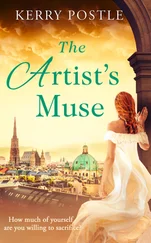A flurry of prospective patrons with a penchant for portraits patrolled the workshop over the following days and weeks. Now there’s a sentence I couldn’t have said at the time. I kept my head down and worked hard. My father’s ire was – for the moment – appeased. And though, after that first day at Sebastiano’s, I’d been demoted to mopper-upper (all because I’d got the name of a painting wrong), I very quickly worked my way up to brush cleaner. Giulio said I was the best. The best brush cleaner he’d ever seen. And, very recently, I had been called on to grind pigments. At last. The job I’d had when I was at Michelangelo’s was mine once more. Giulio had seen to that.
Giulio had a very special talent when it came to drawing that was in great demand. And the guilt he’d felt at the humiliation he’d caused me had prompted him to use his particular drawing skills to help me out. He had an excellent hand and eye when it came to drawing the human form, and Taddeo, in charge of assigning jobs in the studio, had a greedy interest in Giulio’s particular line of work. He was so hungry to accept Giulio’s latest drawing of a young woman, undressed, that he overlooked the fact that I might need training for one of the jobs I was soon going to be called upon to do. That I was managing to grind Verona green, umber, sienna, until I could hide behind their undulating hills of colour, must have misled him. But for now, we had no idea what disaster lurked up ahead. For both of us.
It was a Tuesday, the day that wretched girl came. Or was supposed to. I’d seen her once or twice. She was more graceful than in Sebastiano’s, admittedly unfinished, portrait of her, her features less lumpen. She’d been unreliable of late, and her blatant lack of respect for the maestro divided the apprentices, shocking some (Taddeo and myself), entertaining others (Giulio and everyone else). Out of all the people to pass through the studio, she was the only one who’d ever said buongiorno to me. But I still didn’t like her.
And now Sebastiano was waiting for her to arrive. He paced the studio floor, starting each time a would-be patron came through the door. His face forced a smile as noble after noble looked round the studio with a view to securing a portrait of themselves. The rich and the vain of Rome, unlike the girl with the floury skirt, were queuing up to be painted. They had bags of money with which to pay, while la fornarina clearly paid in other ways. As I peered over my impressive mounds of ground pigment, I observed Sebastiano. His eyes smouldered like hot coals sparking angrily to life every time they caught an apprentice chatting, smiling, looking up from his work. I slumped further down behind my pigment piles. I could only imagine that the girl in the unfinished painting was late with her payment.
A common baker’s daughter, immortalised in paint by one of the finest painters in all Europe. At least, that was the reputation Sebastiano had. She did not realise her good fortune.
I looked on while the nobility of Rome jostled with each other to enjoy the same privilege, bombarding the maestro with questions.
‘Who have you painted?’
‘ Him ? Have you really?’
‘ Her ? Well I never.’
‘ Them ? How marvellous.’
‘Could I possibly see them ?’
‘When can you start?’
‘When can you finish?’
‘How long must I wait?’
Interest was overwhelming. Portraits were easier and evidently more profitable than painting an elaborate fresco cycle for a church or a monastery, they needed less planning and were relatively quick to complete. Sebastiano must have been pleased when he’d turned his hand to them. But as I noticed the colour in Sebastiano’s face rising, caught the flames flickering in his eyes, it was clear portraits were not uppermost in his mind this Tuesday. I kept my head down. He could go off at any second.
‘Have you seen her?’ He drew close to Giulio, his eyes pulled to the door by invisible strings.
I clapped a pigment-covered hand over my mouth as I watched an interested patron reach out to touch a just-finished portrait left to dry on an easel in the corner. ‘The hair, it looks so real,’ he trilled with enthusiasm.
Sebastiano turned. The invisible strings snapped.
‘DON’T TOUCH!’
The nobleman jumped back. When the shock had subsided he glared at the artist.
‘ Signore, it’s best you don’t touch it … per favore !’ Sebastiano added quickly, his good sense returning. It was one thing to shout at one’s apprentices and quite something else to shout at one’s patrons.
‘One drawback with portraits,’ he explained, his tone somewhere between apologetic and grovelling, ‘is the drying time of the oil paint … signore … and it’s a devil to get off one’s fingers.’
Still, portraits were durable (when ready), and easy to display. And fashionable. That made them desirable at any price. That’s why, shouted at or otherwise, this nobleman couldn’t hand his ducats over fast enough in order to seal the deal.
For the next few hours Sebastiano occupied himself with business matters. He needed to simmer down. He sat in a quiet corner with interested patrons, and in a special book he recorded names, measurements, family mottoes, interests, estimated completion times, costs.
But when the business had been settled, and the last of the noblemen had been shown out, it was clear that the maestro still had that girl on his mind.
‘Is she here yet?’
He stood before his painting of her and shouted. ‘Taddeo! I need— Fetch me— Don’t forget— Give me that—’
Sebastiano’s demands spread out across the studio like molten lava and not even my mountains of ground colour could stem the flow.
‘Here, boy. Pietro!’ Taddeo had found me. ‘The maestro needs lamp black.’
‘But I don’t know how to m-m-m …’
With consummate care and attention Taddeo trained me dutifully in the preparation of lamp black by considerately pointing to Cennini’s handbook, il libro dell’arte. Every artist’s workshop had a copy as it told you how to make pens, paper, brushes, work on frescoes, grind pigments – you name it, Cennini’s handbook could tell you how to do it.
‘Chapter th-th-thirty-seven,’ he yelled at me, with the stammer a cruel and unnecessary addition, I thought. There was no need to make fun of me. ‘Everything you n-n-n-need to know is in there.’
Sebastiano mixed lamp black with lead white to form the imprimatura for his paintings, the base for his portrait work. And so he needed it. Lots of it, as portraits were fast becoming his stock in trade. In itself lamp black was comparatively simple to make. And it was quick. The easiest way, according to Cennini, was to burn linseed oil in a lamp and collect the soot created by the process. It needed no grinding, and, once burned, the soot was as fine as powder. Even a fool could make it. ‘Lamp black. Sebastiano needs more lamp black!’ Taddeo shouted at me.
‘Is she here yet?’ the maestro’s plaintive cry reverberated around the studio like an echo. Giulio raised an eyebrow.
*
The following Tuesday the atmosphere in the workshop was even more tense.
‘The takings are down,’ Giulio whispered in my ear as he passed by.
‘B-b-but the p-p-portraits—’
‘I know,’ he said, cutting me off. ‘If he would only allow me to do them.’
I sniffed at Giulio’s arrogance. But he had a point. All Sebastiano had to do was work on the designs, start the drawings. The more experienced apprentices – Giulio among them – could do the rest. But the maestro would not entertain the possibility. Unfortunate, as he was experiencing artistic paralysis, the cure for which was that common girl. I willed her to appear.
Читать дальше












